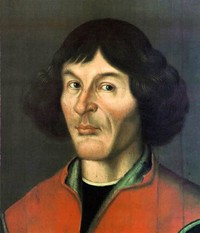Facts about Copernicus
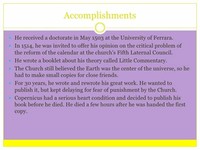
Despite the insistence of many, Copernicus kept delaying the final publication of his book, probably out of fear of criticism for his revolutionary work by the establishment.

By 1536, Copernicus' work was already in definitive form, and some rumors about his theory had reached educated people all over Europe.
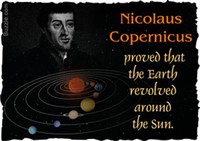
When Copernicus was ten years old, his father, a wealthy businessman and copper trader, died.

Some have suggested that this note may have made Copernicus leery of publication, while others have suggested that this letter indicates that the Church wanted to ensure that his ideas were published.

Copernicus' major theory was published in De revolutionibus orbium coelestium in 1543, the year of his death.
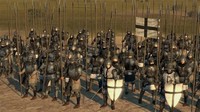
During the war between the Teutonic Order and the Kingdom of Poland (1519–1524), Copernicus successfully defended Allenstein (Olsztyn) at the head of royal troops besieged by the forces of Albert of Brandenburg.

Copernicus held that the Earth is another planet revolving around the fixed Sun once a year, and turning on its axis once a day.

Rheticus became a disciple of Copernicus' and stayed with him for two years, during which he wrote a book, Narratio prima, outlining the essence of the theory.

The archaeologists hoped to find relatives of Copernicus in order to attempt DNA identification.

Galileo's viewing of the phases of Venus produced the first observational evidence for Copernicus' theory.

The Copernican system can be summarized in seven propositions, as Copernicus himself collected them in a Compendium of De revolutionibus that was found and published in 1878.

Legend says that the first printed copy of De revolutionibus was placed in Copernicus' hands on the day he died, so that he could take farewell of his opus vitae.

In 1497, Copernicus' uncle was ordained Bishop of Warmia, and Copernicus was named a canon at Frombork (Frauenburg) Cathedral, but he waited in Italy for the great Jubilee of 1500.

Osiander stated that Copernicus wrote his heliocentric account of the Earth's movement as a mere mathematical hypothesis, not as an account that contained truth or even probability.

Copernicus worked for years with the Prussian Diet on monetary reform and published some studies about the value of money.

Copernicus was aware of this and could not present any observational "proof" in his manuscript, relying instead on arguments about what would be a more complete and elegant system.

De revolutionibus began with a letter from Copernicus' (by then deceased) friend Nicola Schцnberg, the Archbishop of Capua, urging him to publish his theory.

Thomas Kuhn argued that Copernicus merely transferred "some properties to the Sun many astronomical functions previously attributed to the Earth."
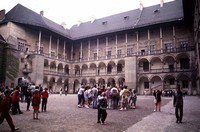
In 1491, Copernicus enrolled at the Jagiellonian University in Krakуw, where he probably encountered astronomy for the first time, taught by his teacher Albert Brudzewski.

Copernicus attended his lectures and became his disciple and assistant.

In 1533, Albert Widmanstadt delivered a series of lectures in Rome, outlining Copernicus' theory.

Copernicus' formulation of heliocentric cosmology, the view that the Sun is at the center of the universe, stands in contrast to Ptolemy's geocentric cosmology, in which the Earth was placed at the center.

The work of the fourteenth-century Arab astronomer Ibn al-Shatir contains findings similar to those of Copernicus, and it has been suggested that Copernicus might have been influenced by them.

On account of geographical and historical uncertainties, it remains a matter of dispute whether Copernicus was German or Polish.
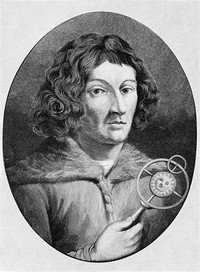
From many parts of the continent, Copernicus received invitations to publish.

Copernicus cited Aristarchus and Philolaus in an early manuscript of his book that survives, stating: "Philolaus believed in the mobility of the Earth, and some even say that Aristarchus of Samos was of that opinion."

In 1542, in Copernicus' name, Rheticus published a treatise on trigonometry (later included in the second book of De revolutionibus).

Copernicus also replaced Ptolemy's equant circles with more epicycles.

Copernicus' maternal uncle, Lucas Watzenrode, a church canon (an administrative position below that of bishop) and later prince-bishop governor of Warmia, reared him and his three siblings after the death of his father.

Copernicus went to Rome, where he observed a lunar eclipse and gave some lectures in astronomy or mathematics.

The experts also determined that the skull had belonged to a man who had died at about age 70—Copernicus' age at the time of his death.

Nicolaus Copernicus (February 19, 1473 – May 24, 1543) was one of the great polymaths of his age.

The first observations that Copernicus made in 1497, together with Novara, are recorded in Copernicus' epochal book, De revolutionibus orbium coelestium (On the Revolutions of the Heavenly Spheres).

Copernicus' major work, De revolutionibus, was the result of decades of labor.

When published, it contained a preface by Copernicus' friend, Andreas Osiander, a Lutheran theologian.

Inspiration came to Copernicus not from observation of the planets but from reading two authors.

